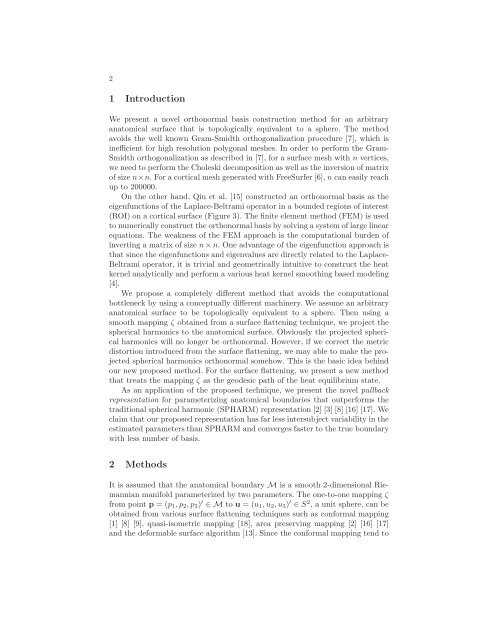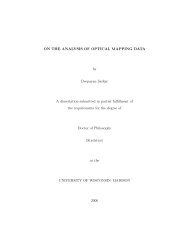Tiling Manifolds with Orthonormal Basis - Department of Statistics ...
Tiling Manifolds with Orthonormal Basis - Department of Statistics ...
Tiling Manifolds with Orthonormal Basis - Department of Statistics ...
Create successful ePaper yourself
Turn your PDF publications into a flip-book with our unique Google optimized e-Paper software.
2<br />
1 Introduction<br />
We present a novel orthonormal basis construction method for an arbitrary<br />
anatomical surface that is topologically equivalent to a sphere. The method<br />
avoids the well known Gram-Smidth orthogonalization procedure [7], which is<br />
inefficient for high resolution polygonal meshes. In order to perform the Gram-<br />
Smidth orthogonalization as described in [7], for a surface mesh <strong>with</strong> n vertices,<br />
we need to perform the Choleski decomposition as well as the inversion <strong>of</strong> matrix<br />
<strong>of</strong> size n×n. For a cortical mesh generated <strong>with</strong> FreeSurfer [6], n can easily reach<br />
up to 200000.<br />
On the other hand, Qiu et al. [15] constructed an orthonormal basis as the<br />
eigenfunctions <strong>of</strong> the Laplace-Beltrami operator in a bounded regions <strong>of</strong> interest<br />
(ROI) on a cortical surface (Figure 3). The finite element method (FEM) is used<br />
to numerically construct the orthonormal basis by solving a system <strong>of</strong> large linear<br />
equations. The weakness <strong>of</strong> the FEM approach is the computational burden <strong>of</strong><br />
inverting a matrix <strong>of</strong> size n × n. One advantage <strong>of</strong> the eigenfunction approach is<br />
that since the eigenfunctions and eigenvalues are directly related to the Laplace-<br />
Beltrami operator, it is trivial and geometrically intuitive to construct the heat<br />
kernel analytically and perform a various heat kernel smoothing based modeling<br />
[4].<br />
We propose a completely different method that avoids the computational<br />
bottleneck by using a conceptually different machinery. We assume an arbitrary<br />
anatomical surface to be topologically equivalent to a sphere. Then using a<br />
smooth mapping ζ obtained from a surface flattening technique, we project the<br />
spherical harmonics to the anatomical surface. Obviously the projected spherical<br />
harmonics will no longer be orthonormal. However, if we correct the metric<br />
distortion introduced from the surface flattening, we may able to make the projected<br />
spherical harmonics orthonormal somehow. This is the basic idea behind<br />
our new proposed method. For the surface flattening, we present a new method<br />
that treats the mapping ζ as the geodesic path <strong>of</strong> the heat equilibrium state.<br />
As an application <strong>of</strong> the proposed technique, we present the novel pullback<br />
representation for parameterizing anatomical boundaries that outperforms the<br />
traditional spherical harmonic (SPHARM) representation [2] [3] [8] [16] [17]. We<br />
claim that our proposed representation has far less intersubject variability in the<br />
estimated parameters than SPHARM and converges faster to the true boundary<br />
<strong>with</strong> less number <strong>of</strong> basis.<br />
2 Methods<br />
It is assumed that the anatomical boundary M is a smooth 2-dimensional Riemannian<br />
manifold parameterized by two parameters. The one-to-one mapping ζ<br />
from point p = (p 1 , p 2 , p 3 ) ′ ∈ M to u = (u 1 , u 2 , u 3 ) ′ ∈ S 2 , a unit sphere, can be<br />
obtained from various surface flattening techniques such as conformal mapping<br />
[1] [8] [9], quasi-isometric mapping [18], area preserving mapping [2] [16] [17]<br />
and the deformable surface algorithm [13]. Since the conformal mapping tend to
















